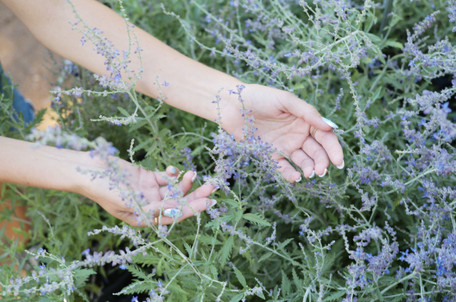Perovskia
Posted by Aaron Barton on Aug 8th 2022
Perovskia (Russian Sage)
A breathtaking perennial classic, Russian Sage is a durable and carefree plant perfect for adding structure and lasting late season color in the garden, performing beautifully in tall borders and foundation plantings, and stunning when massed as a shrubby border. Perovskia atriplicifolia (pe-ROF-ski-ah a-tri-pli-si-FO-li-ah), also known as Russian Sage, is a unique semi-woody, deciduous subshrub, producing new herbaceous growth from its perennial woody base each spring and flowering only on new growth, though remaining upright through the winter months for multi-season interest and crown protection.
Native to regions of central and southwestern Asia, Russian Sage is the perfect selection for low maintenance, stress-free gardening, with exceptional drought tolerance, resistance to animal feeding, tolerance to road salt, and generally few pest or disease concerns. A member of the mint family, Lamiaceae, Perovskia is named after the Imperial Russian General Vasily Perovsky, and while previously of its own genus, Perovskia is now considered a subgenus of the larger Salvia genus, taxonomically reclassified in 2017 as Salvia yangii, though still typically referred to by its more familiar name, Perovskia.
Preferring well-drained soil in areas of full sun, Russian Sage thrives in hot, sunny, and dry conditions, reaching a mature size of three to four feet tall and wide with a loosely upright habit. However, smaller cultivars such as the compact ‘Blue Jean Baby’ offer a smaller option as well, standing two to three feet tall and wide with densely blooming flower panicles. Perovskia produce upright, square-shaped, dusty gray-green stems covered in small gray hairs, with finely textured, scented foliage that creates a wonderful airy appearance in the garden.
Beginning in mid-summer, Russian Sage blooms long flower panicles of numerous hazy blue buds with attractive purple calyxes to provide color as blooms begin to open in a vibrant lavender blue display. Blooms continue throughout mid-summer and into fall, with their calyxes persisting to provide colorful interest even after the blooms themselves have faded, further extending the long-lasting color and beauty of Russian Sage. Leave stems standing through the winter to protect the woody base and provide winter interest, cutting down to about six to eight inches in early spring before new growth emerges. Deadheading can be performed if desired for a tidier appearance, but will not encourage reblooming.
Happy planting!

